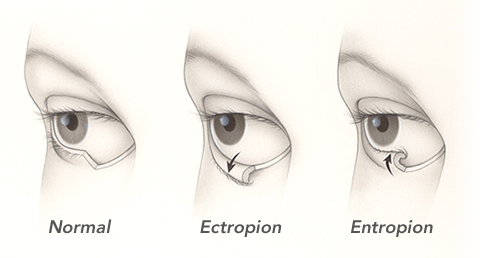Entropion Causes, Symptoms, Diagnosis and Treatment

What is Entropion?
Entropion is a medical condition in which the eyelid (usually the lower lid) folds inward.
It is very uncomfortable, as the eyelashes constantly rub against the cornea and irritate it. Entropion is usually caused by genetic factors.
The upper or lower eyelid can be involved, and one or both eyes may be affected. When entropion occurs in both eyes, this is known as “bilateral entropion.”
Artificial tears and lubricating ointments can help relieve symptoms of entropion, but surgery may be needed.
Causes of Entropion:
Entropion may be caused by a number of reasons. These include:
- Muscle weakness.
- As one ages, the muscles under the eyes tend to get weaker and the tendons also may relax. If muscles and tendons become weak and relaxed, entropion can develop.
- Scars or previous surgeries.
- Scarred skin from chemical burns, trauma or surgery can distort the normal curve of the eyelid, causing entropion.
- Eye infection.
- An eye infection called trachoma can cause scarring of the inner eyelid, leading to entropion and even blindness from the corneal complications.
- Inflammation or infection.
- An eyelid problem called spastic entropion can result from infection or inflammation.
- Developmental complication.
- Very rarely, entropion is present at birth (congenital). More often, a baby with turned-in eyelashes at birth has an extra fold of skin on the eyelid, called epiblepharon.
Symptoms of Entropion:
The following signs and symptoms are exhibited:
- The feeling that there’s something in the eye
- Redness of the white part of the eye
- Eye irritation or pain
- Sensitivity to light and wind
- Watery eyes (excessive tearing)
- Mucous discharge and eyelid crusting
- Decreased vision
Diagnosis of Entropion:
Entropion can be easily diagnosed via:
- Routine eye examination
- Physical examination
Treatment of Entropion:
Although treatments besides surgery are available, they only provide temporary relief. In the end, surgery is necessary.
Treatment options include:
- Short term treatment
- Skin tape.
- Special transparent skin tape can be applied to the eyelid to keep it from turning in.
- Stitches that turn the eyelid outward.
- The stitches turn the eyelid outward, and resulting scar tissue keeps it in position even after the stitches are removed.
- OnabotulinumtoxinA (Botox).
- Small amounts of onabotulinumtoxinA injected in the lower eyelid can turn the eyelid out.
- Surgery
By : Natural Health News




